|
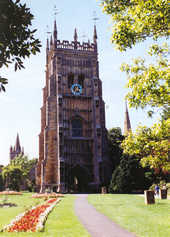
Abbott
Lichfield's early sixteenth century bell
tower still dominates the Evesham skyline.
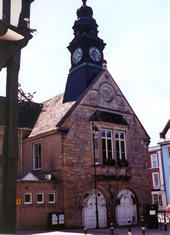
Part of the
Town Hall in
the Market Place.
The building is
disappointing, for
although it dates back
to the sixteenth and seventeenth centuries,
it has been repeatedly extended and today its appearance is
overwhelmingly Victorian
or later.
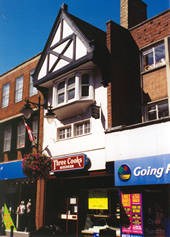
The house in
Brige Street,
now a bakery, where
Charles I stayed in 1644.
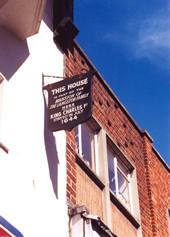
Charles's
presence
commemorated by a
small first floor sign
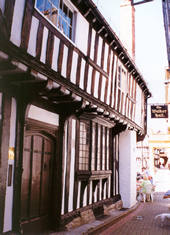
The
timber-framed
and jettied Walker Hall,
by the medieval gateway
which linked the town
and the abbey precinct.
|
Cromwellian Britain - Evesham,
Worcestershire
Evesham is more usually associated with a thirteenth
century battle than with any events of the Cromwellian period. On
Greenhill, above the town on the Stratford-upon-Avon road, the forces of
Simon de Montfort were in 1265 routed by Prince Edward, loyal to King
Henry III, and portions of the corpse of the luckless Simon were
dispatched to various parts of the kingdom pour encourager les autres.
Monks of Evesham Abbey, around whose walls the town grew during the
Middle Ages, nurtured a cult of Simon de Montfort and kept his memory
green. By 1640 the town had for a century been weaned from the
institution and the faith which had brought it into being. Abbot Clement
Lichfield’s bell tower, raised in the 1530s, which still dominates the
Evesham skyline, was the last flourish of a relationship between
monastery and community; from the Dissolution of 1540 to the end of the
seventeenth century, the town depended on the cloth trade, and
particularly the specialist trades in finished articles – caps, collars
and gloves. By 1640 the townspeople were busily quarrying the ruined
abbey walls for building stone.
The town only first received a royal charter in 1603, as a result of the
influence the vicar of Evesham, Lewes Bayly (a future bishop of Bangor)
had as chaplain to James I’s eldest son, Prince Henry. The town was
important not only as an industrial centre, but as a staging post
between Oxford and Worcester and routes west to Wales. Evesham was
garrisoned for the king early in the civil war, but relations between
royalists and citizens were not easy. Townspeople resented the
disruptions that the military presence brought to the weekly markets
held in the centre of the town, and Charles’s party came to regard their
reluctant hosts as treacherous. Like other clothworking towns of the
west Midlands, the west of England and the south-west, Evesham was in
matters of culture and religion, at least, more attuned to the thinking
of parliament than that of the king. Nevertheless, with the exception of
Alderman Samuel Gardner, who deserted his post as mayor to sign up for
service in the army of the parliamentarian Lord Brooke of Warwick
Castle, the common councillors of Evesham laid low and said nothing, or
more accurately carried on business as usual, during the royalist
occupation.
Because of the king’s choice of Oxford as his headquarters after the
battle of Edgehill in October 1642, much of the subsequent military
campaign turned on troop movements in the southern west Midlands and
Wales, and so Evesham found itself frequently the focus of strategists’
attentions. Charles stayed in the town in 1644, probably in one of the
town houses in Bridge Street that were crown property.
The townspeople of Evesham may have had good reason to resent Charles’s
presence; their lifeline to the rich Cotswold sheep pastures, the bridge
over the Avon dividing Evesham from Bengeworth, was smashed by the king
as he left for Oxford in June 1644. Through the remainder of that year,
Evesham continued to be used as a royalist garrison, but parliamentarian
surprise raids became bolder and more successful; in June a raiding
party took a royalist lieutenant, three cornets and sixty men prisoner
within a mile of the town.
From January 1645, Colonel Edward Massey of the parliamentary garrison
of Gloucester was being asked by the Committee of Both Kingdoms to
reduce the garrison at Evesham. His chance came in the spring of that
year; on Saturday 24 May 1645, a force of 800 horse and 600 foot from
Gloucester took up positions outside the town. Evesham lies in a bend in
the River Avon, and is thus surrounded on three of its four sides by
water. It had no town walls. Troops were positioned on the south side
across the river, and on the north (Alcester/Stratford) side. Sunday was
spent in preparations. The defenders had built a ditch and hedge of
faggots and brushwood on the north side, and trusted that the waters of
the Avon would do the rest. On the Monday, the attack seems to have come
from the north. The parliamentary troops must have attacked downhill
from Greenhill, the site of the 1265 battle, and brought ladders to
scale the defences. They seem to have proved easy to penetrate in
several places. ‘The storme’, according to an eyewitness report, ‘lasted
almost an houre with great fury on both sides’, but the royalists were
quickly overrun and subdued. The casualties were seven killed and thirty
wounded on Massey’s side, while the royalists lost eleven men. In all
about 548 royalist soldiers were taken prisoner. The spoils of war
induded 200 horses, twenty barrels of powder, 700 firearms and two tons
of match. After the event, the county committee of Worcestershire, now
based in Evesham, included a payment of 2s 6d for ‘ladders and other
materialls’ used at the siege.
Although there were subsequently a few rumours that Evesham was likely
to be taken again by the king, the town remained in the control of
parliament. Its Interregnum history is more interesting than its slight
military claim to fame. While the siege was going on, there was a brawl
in an Evesham tavern over the integrity of the king. A townsman, Edward
Pitway, defended the honour of parliament against the declarations of a
cavalier in extremis. Pitway was a burgess of Evesham, and rallied to
the cause of the Commonwealth in 1651, helping to rout the forces of
Charles Stuart at Worcester. By August 1655 Pitway was at the centre of
a fierce struggle for authority in the town between a group of Quakers
and the mayor, aldermen and burgesses.
The details of the case of the Evesham Quakers can be followed in a
recent article.[1] The town was visited by an itinerant preacher,
Humphrey Smith of Little Cowarne, Herefordshire, who gathered around him
a group of families who rejected the orthodox Calvinism of the minister,
George Hopkins, and at the same time viewed the town fathers as soft on
drunkards and swearers. The leaders of the sect were rounded up and
imprisoned in various places in the borough around the Market Place, and
leading town burgesses strove to incite a mob to taunt the prisoners in
their cell. It was at this point that Edward Pitway intervened on the
prisoners’ behalf and ‘came out’ as a Quaker himself.
As a response to their ill-treatment, the Evesham Quakers, under the
leadership of Humphrey Smith, wrote to the Protector, and at the same
time published their letter. The magistrates of the town were further
incensed and tried Pitway, Smith and fourteen others for libel. Quaker
books were burned at the cross in the Market Place.
Eventually, through the good offices of Major-General James Berry, the
Protector issued a warrant for the release of the Quakers, confirming
Berry’s verdict that he could not understand ‘either their faults or
their fines’. Thereafter the Quakers were persecuted intermittently
through the rest of the Interregnum and into the mid 1660s. Their case
illustrated the fear that the socially and theologically conservative
town rulers had of the unorthodox behaviour of the radical sectaries –
their refusal to doff their hats and their unwillingness not to
proselytise. More importantly in the local Evesham context, however, the
Quakers became a magnet for those unhappy with the lack of a radical
agenda in government, with spiritual poverty in parts of the town and
with the reluctance of the civic authorities to support the clauses in
the Instrument of Government which established a measure of religious
toleration.
The siege of Evesham was brief and its implications short lived. The
furore over the Quakers split the town, led to a period of faction
fighting in the town government and created a permanent Protestant
nonconformity there.
The modern visitor to Evesham has to look hard for relics of the mid
seventeenth century. The probable line of the royalist defences in 1645
ran from the river where the modern railway line from Oxford crosses it
in the east, along what is now a railway cutting, to join the river on
the west side. Modern development, including the railway, has certainly
obliterated most of the line of the defences, but at the north end of
Briar Close a footpath is visible running down a narrow lane. Where the
lane peters out the remains of a hedge and ditch may be seen running
down to the river, and this probably marks the last surviving trace of
the civil war defences (OS 40332444). The Market Place in the centre of
the town contains the town hall, where the Quakers were tried for
sedition. The hall is late sixteenth century, but with many later
additions. It has long been a tradition – it certainly seems highly
plausible – that the Quakers were imprisoned in the cellar of what is
now called the Walker Hall, until recently the town lending library. The
market cross, at which over sixty Quaker books were burnt in 1655, stood
in the Market Place where the doors of the modern Abbey Gate shopping
centre give on to it, but the cross itself was pulled down in the
eighteenth century.
In Bridge Street, on the left going down, is the house where Charles
stayed in 1644. A sign hanging from the first storey barely advertises
the fact; the house itself is now a baker’s shop. The Bengeworth or
Evesham bridge, destroyed by Charles I, was rebuilt during the late
1640s but the present structure is Victorian.
Notes.
1. Stephen Roberts, ‘The Quakers in Evesham 1655-60: a study in
religion, politics and culture’, Midland History 16 (1991), pp. 63-85.
By Dr Stephen Roberts
|
